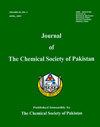Characterization of Synthesized SnO2 Nanoparticles and its Application for the Photo Catalytic Degradation of Eosin Y in Aqueous Solution
IF 0.5
4区 化学
Q4 CHEMISTRY, MULTIDISCIPLINARY
引用次数: 0
Abstract
The synthesized oxide (SnO2) nanoparticles by sol-gel method were characterized using UV-Visible spectroscopy (UV-Vis), Fourier Transform Infrared spectroscopy (FTIR), X-rays diffraction(XRD) and Scanning electron microscopy(SEM). Using X-rays diffraction analysis different parameter were calculated such as crystallite size, d-spacing, dislocation density, number of unit cell, cell volume, morphological index, micro strain and instrumental broadening. The average particle size was 28.396 nm. Scanning electron microscopy revealed that SnO2 nanopartcles are uniformly distributed. Optical properties such as band gap (energy gap = 3.6 eV) was calculated from UV-Visible spectroscopy. The characterized particles were used as photocatalyst for the degradation of Eosin dye in aqueous solution under UV light. The effect of different parameters i.e irradiation time, initial dye concentration, pH of the medium and catalyst weight on percent degradation was also studied. Mmaximum dye degradation was found at 220 minutes time interval that was 92 % using 10 ppm solution. At pH 5 the degradation of dye was found to be 94%. The catalyst dose of 0.06 g was found to be the optimum weight for the best photo catalytic degradation of Eosin Y.合成SnO2纳米颗粒的表征及其光催化降解水溶液中伊红Y的应用
采用溶胶-凝胶法制备的氧化SnO2纳米颗粒,采用紫外可见光谱(UV-Vis)、傅里叶变换红外光谱(FTIR)、x射线衍射(XRD)和扫描电镜(SEM)对其进行了表征。利用x射线衍射分析计算了晶体尺寸、d间距、位错密度、晶胞数、晶胞体积、形态指数、微应变和仪器展宽等参数。平均粒径为28.396 nm。扫描电镜显示,SnO2纳米颗粒分布均匀。利用紫外可见光谱法计算带隙(能隙= 3.6 eV)等光学性质。用所表征的颗粒作为光催化剂,在紫外光下降解水溶液中的伊红染料。考察了辐照时间、初始染料浓度、介质pH和催化剂质量对降解率的影响。使用10 ppm溶液,在220分钟的时间间隔内染料降解率达到92%。在pH为5时,染料的降解率为94%。结果表明,光催化降解伊红Y的最佳催化剂用量为0.06 g。
本文章由计算机程序翻译,如有差异,请以英文原文为准。
求助全文
约1分钟内获得全文
求助全文
来源期刊
CiteScore
1.30
自引率
14.30%
发文量
41
审稿时长
3.4 months
期刊介绍:
This journal covers different research areas in the field of Chemistry. These include; Analytical Chemistry, Applied Chemistry, Biochemistry, Environmental Chemistry, Industrial Chemistry, Inorganic Chemistry, Organic Chemistry and Physical Chemistry. The journal publishes full length articles and Reviews from researchers in academia in addition to featuring comments. Chemical Research presents short, concise and critical articles offering easy-to-read overviews of basic research and applications in all areas of chemistry.

 求助内容:
求助内容: 应助结果提醒方式:
应助结果提醒方式:


